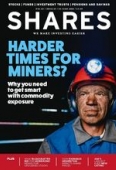Archived article
Please note that tax, investment, pension and ISA rules can change and the information and any views contained in this article may now be inaccurate.
What to do if one of your investments warns on profit

A ‘profit warning’ is where a company’s actual profit is materially lower than forecasts set by sell-side analysts and can cause an investor acute portfolio pain; reports of an earnings ‘miss’, a material deterioration in trading or an unforeseen shock are typically punished by brutal share price slumps.
Profit warnings come with the territory when putting money into equities and you’ll probably encounter many of them during your investing life. The best advice is not to panic and to try and work out if problems can be fixed. If they can’t, you may have to consider selling out, even if it means incurring a loss.
WHAT CAUSES A WARNING?
Profit warnings can be triggered by various factors such as lost sales, missed contracts and supply chain issues or macro-economic reasons and they can create confusion for investors. Some view them as a ‘buying opportunity’, while others avoid ‘catching a falling knife’ and buy into the old adage they always ‘come in threes’, which is something of an investment myth.

Sometimes profit warnings come out of the blue, but often a share price will underperform the market ahead of a profit warning, which can be explained by two factors; the industry backdrop may have already started to deteriorate and the market has begun to price this deterioration into the share price; and insiders may have leaked some information to analysts.
Many investors will hold on to shares in a troubled company in the hope they will recoup some of their losses, though research by Stockopedia has found there are extremely low odds of outperforming the market over a one-year basis by continuing to hold a share that has suffered a profit warning.
As a general rule of thumb, if a profit warning stems from a clearly identified problem that looks like it can be fixed by short term management actions, the chances of a full recovery in the share price are good to fair. However, anything related to falling demand for a company’s products or a rapid change in the competitive landscape is usually bad news for the longer term development of the business, and the share price.
DIFFERENT LEVELS OF WARNINGS
Understandably, companies will try and put the best possible spin on things when they are forced to issue profit warning, but there are different warning levels. For instance, a ‘broadly in-line’ statement is typically interpreted as a small miss against market expectations. Price reactions can vary, but generally a 5% to 10% fall in the share price would be a common reaction.
‘Moderately below’ market expectations is a clear statement that performance has fallen short of consensus expectations and is generally understood by market professionals to mean 10% to 15% below expected earnings. Share price declines with these types of warnings can be more brutal, in the range of 20% to 30%.
Sometimes, a company will report that earnings are ‘significantly’ or ‘materially below’ market forecasts. In these cases, investors should brace themselves for a 20%-plus miss or perhaps a loss against a previously expected profit. Share price reactions can be falls of 50% or more, as in the example of MySale (MYSL:AIM).

MYSALE’S IN THE 90% CLUB
Online retailer MySale floated on AIM at 226p in June 2014 and just six months later (15 Dec 2014) issued a severe profit warning that destroyed investors’ confidence in the story. In the poorly received update, MySale warned that while full year revenues would show double-digit growth, pre-tax profit would be ‘materially below market expectations’ due to challenging trading conditions in its original markets of Australia and New Zealand.
This sent the shares down 53% to 81.5p on the day of the warning. Today, they are priced at just 7.7p, 97% below the IPO issue price, with investors put off by the unpredictability of the business which has resulted in upgrades, downgrades, losses and much else in the intervening seven years.
A VARIETY OF WARNINGS
Global products and pharmaceutical services company Clinigen (CLIN:AIM), sank 26.5% to 615p after warning in June 2021 profit would be lower than guided as Covid-19 continued to impact hospital-based cancer treatments and delayed clinical trials. McBride (MCB), the private label consumer goods maker, endured a 16% plunge to 78.8p on 5 May 2021 after unexpectedly cutting its annual earnings estimate due to a combination of slower sales growth and a ‘rapid, significant and sustained price escalation’ in many raw materials.
And online competitions provider Best of the Best (BOTB:AIM) slumped 32% to £18 on the day of strong final results in June 2021 on what was read as a profit warning. The company said it had experienced ‘somewhat of a reduction in customer engagement’ since the latest easing of lockdown restrictions on 12 April 12, ‘specifically relating to the understandably long-awaited re-opening of hospitality and non-essential retail’.
Another example is Frontier Developments (FDEV:AIM). Though the video games developer said in a June 2021 update that it expected to report record revenues for the year to May 2021, analysts downgraded forecasts due to Covid-related development challenges which have delayed planned launches.
Specifically, the release of its Jurassic World Evolution 2 title would now fall into the financial year to May 2022, while the first of the annual F1 Manager title was expected to launch early in the 2023 financial year, so after 1 June 2022, rather than in full year 2022, with the following iterations all pushed back a financial year.
THE FUND MANAGER’S VIEW

Michael Crawford, manager of the TB Chawton Global Equity Income Fund (BJ1GXX3), points out profit warnings ‘pertain to the short term ranging from a quarter up to a year’. However, he says their implications can ‘stretch much further into the future depending on the cause.
‘Most seriously, if it is caused by competitor or substitute products starting to take market share or compete away high returns on capital, the implied value of the company can fall steeply.’
Conversely, ‘if a company is increasing investment and therefore expense, which will improve longer term growth rate and returns, it could actually increase implied value’.
Crawford says many quoted companies suffer from ‘a misalignment between long-term shareholders and executive management often caused by the lack of influential shareholders with a long-term mindset’.
In such cases, ‘management can persuade weak boards to incentivise by annual earnings per share (EPS) growth. So incentivised, such teams will prioritise and normally meet or exceed short term earnings expectations even if it is to the long-term detriment of the company’.
Crawford says they will ‘also be overtly optimistic and lack candour. Such companies tend to attract shareholders with shorter term time frames. When such a company warns, the effect can be catastrophic and investors, fearing the worst, will normally bail out. GE (General Electric), under Jack Welch, is the classic example’.
In contrast, other companies are ‘much better aligned with long-term shareholders due to founders or families with large holdings or as a result of cultural values embedded by a former high-quality manager. Incentivisation structure will be based on return on invested capital and longer-term growth.
‘Management will be more candid and transparent with what is actually going on and their thinking. This will attract longer term shareholders who will stand behind the company even when profits are reduced significantly in the short term.
‘One of the best exponents of this is Next (NXT) under the leadership of Simon Wolfson. His reports to shareholders are amongst the clearest there are in explaining where the business is doing well, where not so and how the company’s strategy is developing.’
Important information:
These articles are provided by Shares magazine which is published by AJ Bell Media, a part of AJ Bell. Shares is not written by AJ Bell.
Shares is provided for your general information and use and is not a personal recommendation to invest. It is not intended to be relied upon by you in making or not making any investment decisions. The investments referred to in these articles will not be suitable for all investors. If in doubt please seek appropriate independent financial advice.
Investors acting on the information in these articles do so at their own risk and AJ Bell Media and its staff do not accept liability for losses suffered by investors as a result of their investment decisions.

 magazine
magazine








